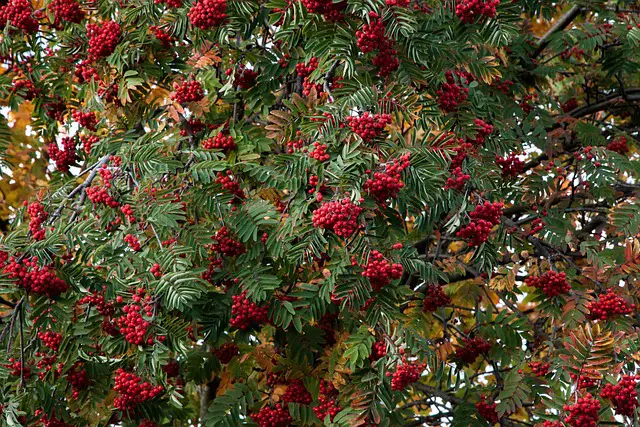Mountain ash berries, also called rowan berries, are reddish-orange fruits with a long and interesting history in the United States, Europe, and Asia.
Generally speaking, these wild fruits are considered edible; however, there are some important caveats to this, especially concerning their taste. So, the question becomes twofold. Can we eat them? And also, should we eat them?
Are Mountain Ash Berries Edible?
Yes, we can eat mountain ash berries, but we’ll want to think more about how we do that if we’re actually going to enjoy them. These brightly colored berries are very astringent. You will be hard-pressed to find a forager who tells you that eating these berries fresh off the tree is a real treat. Most people who seek these berries out will collect them and use them to make fresh baked goods, jellies, or jams. They also make a sauce similar to applesauce, sometimes when mixed with other fruits. Additionally, they have a long history of being made into alcohol, including wine.
Rowan berries don’t exactly taste like a cranberry, but they do enough so that putting them in recipes that call for cranberries is a good place to start your culinary adventures with mountain ash berries.
It is also fair to compare the mountain ash berry to the chokecherry. Both have a very astringent flavor that most people don’t enjoy fresh. Both of these fruits also have seeds that are dangerous to eat. The insides of the seeds contain a compound that becomes cyanide in the body when digested. For this to happen, the seed needs to crack open, and a fairly large number of the seeds need to be consumed. This means that as long as you are generally careful to remove the seeds from the fruit, mountain ash berries are safe to eat. Since you will also likely be cooking the berries, you’ll want to find recipes where removing the seeds is part of the process.
Mountain ash berries have been consumed for centuries for their nutritional benefits, particularly their high vitamin C content. They used to be an excellent choice for helping sailors avoid scurvy, an illness caused by vitamin C deficiency.
However, it’s crucial to exercise caution when considering their edibility. These berries contain parasorbic acid, which imparts a bitter taste and can be mildly toxic if consumed in large quantities. To make the berries safe for consumption, they can be subjected to the first frost, which converts the parasorbic acid into a safer form. Cooking them also cuts down on this compound, making them safer to eat.
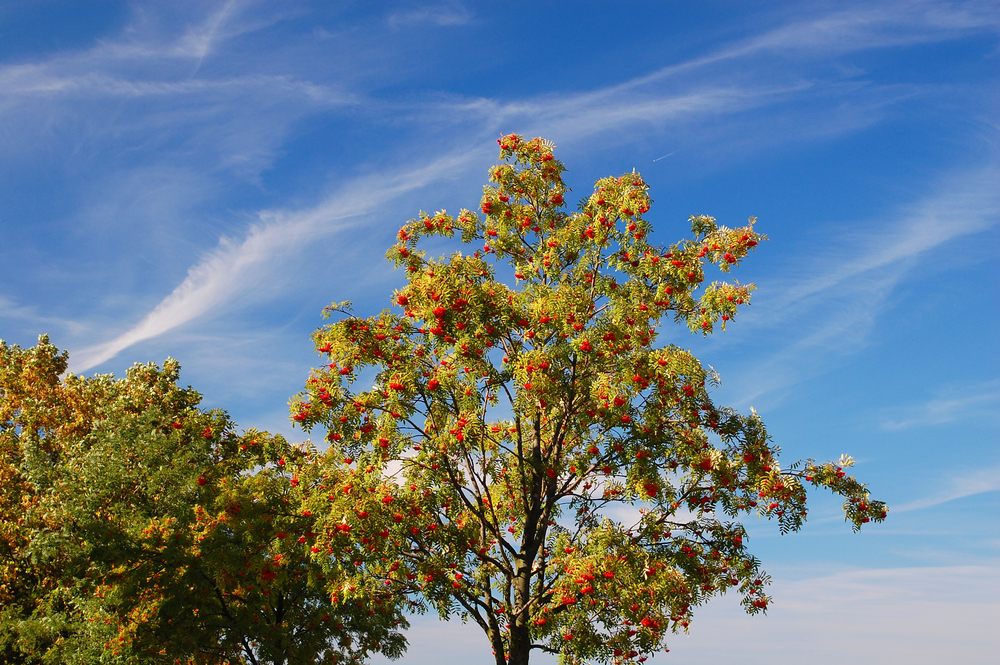
The Mountain Ash Tree
The mountain ash tree, also referred to as the rowan tree, belongs to the genus Sorbus and is scientifically termed Sorbus aucuparia in Europe. Another variety is the Sorbus decora, which is usually known as the showy mountain ash. In the United States, we commonly find the Sorbus americana, though the Sorbus aucuparia is still most common in North America.
This small deciduous tree is a member of the rose family and is often cultivated as an ornamental tree due to its beautiful compound leaves and showy clusters of small white flowers that appear in late spring to early summer. The tree thrives in acidic soils and is native to various regions, including Europe, North America, and parts of Asia.
A Multitude of Common Names
The mountain ash tree goes by various common names, such as European mountain ash, rowan tree, and service tree. In North America, it is also known as American mountain ash or Sorbus americana. This rich tapestry of common names reflects the widespread cultural significance and historical uses of this tree dating back to ancient times.
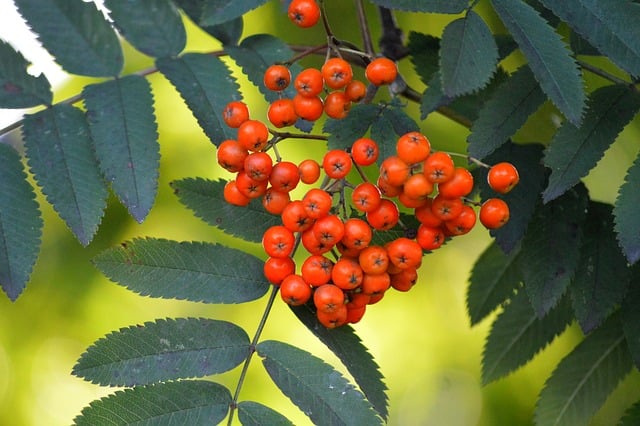
A Closer Look at Foraging For These Reddish-Orange Berries
In order to really enjoy foraging for these berries, you’ll want to pay especially close attention to the time of year you pick them and how you prepare them.
One of the most intriguing aspects of the mountain ash tree is its edible fruit – the mountain ash berries. These berries, often seen in shades of red, orange, or yellow, hang in clusters, adorning the tree in late summer through early fall, making it a delightful sight for foragers. The berries are sometimes referred to as “bare berries” due to their exposed appearance within the fruit clusters.
Foragers in the United States will want to look for these berries on the east coast. In North America, the American mountain ash (Sorbus americana) graces the landscapes of various states, offering its berries to those who seek them. From the northeastern regions, including Maine and Vermont, to the midwestern states, like Michigan and Minnesota, these trees add a touch of elegance to the natural tapestry. Their presence can also be appreciated in parts of Canada, extending from Nova Scotia to British Columbia.
When to Forage for Rowan Berries
The berries may appear mostly ripe in August through November. However, most foragers choose to wait until the leaves have fallen and the weather has cooled. Mountain ash berries tend to taste sweeter after the first frost. This may sound like an old wive’s tale. However, you’ll meet foragers or find online accounts of people who have picked the berries before and after the first frost, saved them, and then tasted them side by side. These first-hand accounts report that this isn’t just an old wive’s tale. The berries lose some of their bitter compounds and become sweeter once they’ve gone through the first frost. In fact, they can often go through a couple of frosts still clinging to the tree and still taste delicious.
This natural process can be mimicked by putting your fresh berries in the freezer, but isn’t the same as letting them freeze on the tree.
A good practice is to watch for these trees while you’re hiking and take note of their location. Then, when autumn is in full swing, come back and pick the fresh berries off the bare branches.
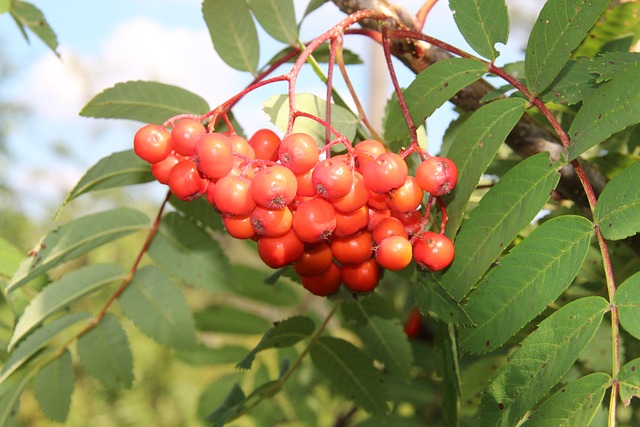
Embracing the Sunlight
Mountain ash trees are no strangers to the embrace of sunlight. While they can tolerate partial shade, they tend to thrive when basking in the sun’s rays. This affinity for sunlight is evident in their growth patterns and fruit production. When placed in spots that receive ample sunlight, the mountain ash tree rewards us with bountiful clusters of berries.
Exploring the European Connection
Across the Atlantic, the European mountain ash (Sorbus aucuparia) paints the landscapes of Europe with its distinctive foliage and vibrant berries. From the United Kingdom to Scandinavia and beyond, these trees stand as a testament to the enduring relationship between humans and the wild. Their adaptability to various altitudes and climates has allowed them to thrive in environments ranging from lowland woodlands to mountainous regions.
Historical and Medicinal Uses
Throughout history, mountain ash berries have found their way into traditional medicine. Native Americans, for instance, used berries from species like Sorbus decora for various remedies. The inner bark was used to treat sore throats, the leaves were used as a remedy for colds, and the berries were valued for their potential to provide relief from kidney-related issues.
Differentiating Mountain Ash Berries
It’s important to note that while mountain ash berries are generally safe to eat when properly prepared, there are other berries that share a resemblance but are not edible. Crab apples and other species of the rowan section may have similar leaves and fruit clusters, but they are not the same as mountain ash berries. Hence, it’s crucial to be absolutely sure of your identification before consuming any wild berries.
One of the reasons it can be particularly tricky to identify the mountain ash berries is that they taste best after the first frost. This means that the branches of the tree are bare, and foragers don’t have the tree’s leaves readily available. Looking at the leaves is often one of the best ways to make sure you’re correctly identifying a berry.
One trick for this is to look on the ground directly below the branches and see if you can find a plethora of leaves that look like rowan leaves. You may see some from other trees, so you really want to see an abundance of rowan tree leaves if you’re using this as proof.
Another tip is to look at the tree’s bark as closely as you can. You can also open up one of the rowan berries and get a look at its seed. Try to use more than one field guide, preferably with pictures of the seed, leaves, bark, and berries themselves.
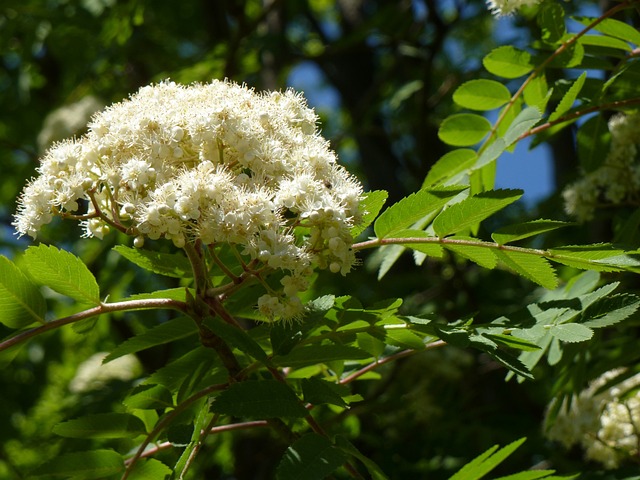
Rowan Trees For Landscaping?
The rowan tree, often referred to as the mountain ash, has gracefully made its way into the hearts and landscapes of Americans. Its unique blend of ornamental beauty, year-round interest, and wildlife-friendly attributes makes it a beloved addition to gardens, parks, and urban environments across the country. As more people discover the enchanting allure of this tree, it continues to bridge the gap between nature and civilization, reminding us of the wonders that the natural world can bring to our daily lives.
One of the primary attractions of the rowan tree lies in its visual appeal. With its striking compound leaves and clusters of delicate white blossoms that appear in late spring, the tree is a showstopper throughout the growing season. However, the real spectacle arrives in late summer as the tree becomes adorned with its signature berries. These vibrant orbs, ranging from shades of red to orange, create a dazzling display that transforms any garden or landscape into a work of art.
Unlike some trees that showcase their beauty for only a short period, the rowan tree is a four-season wonder. In spring, it graces us with its blossoms; in summer, its lush foliage provides shade and shelter for local wildlife; come late summer, the berries ripen, adding a burst of color; and in the fall, its leaves turn vibrant shades of red, orange, or gold, making it a focal point in any autumn landscape. This year-round interest ensures that the rowan tree remains a favorite among gardeners.
Beyond its aesthetic appeal, the rowan tree also plays a crucial role in supporting local wildlife. Birds, in particular, are drawn to its berries, providing them with a valuable food source as winter approaches. For nature enthusiasts and birdwatchers, the rowan tree serves as a magnet for a diverse range of avian visitors, adding another layer of life and vibrancy to the landscape.
Enjoying the Foraging Adventure for Rowan Berries
Did you know that you can find ancient Viking recipes that include rowan berries? When you head out into the woods looking for these delightful fruits, you’re taking part in a tradition with roots through Native American history, Scandinavian history, and more. The number of recipes you can find in history books or on Pinterest is endless. If you happen to find a bounty of mountain ash berries, you won’t have any trouble finding new ideas for how to use them. The vibrant hues of these berries hanging in clusters amidst the leaves of the mountain ash tree remind us of the wonders that the natural world has to offer.
With their rich history, potential health benefits, and careful preparation, these berries can be a cherished addition to the forager’s basket. Just remember to exercise caution, enjoy them in moderation, and savor the unique flavors that the mountain ash berries bring to the table.
Recent Posts
The only venomous snakes in Washington State are Northern Pacific Rattlesnakes. The Northern Pacific Rattlesnake (Crotalus oreganus oreganus) is a sub-species of the Western Rattlesnake. Anyone...
Skunks are not classified as true hibernators. But they go into a state of torpor when the weather gets cold. Skunks are light sleep hibernators, along with opossums, bears, and raccoons. ...

